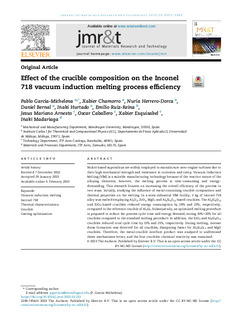Título
Effect of the crucible composition on the Inconel 718 vacuum induction melting process efficiencyAutor-a (de otra institución)
Otras instituciones
Universidad de MálagaITP Aero Casting
Versión
Version publicadaTipo de documento
ArtículoArtículoIdioma
engDerechos
© 2023 The AuthorsAcceso
Acceso abiertoVersión del editor
https://doi.org/10.1016/j.jmrt.2023.01.213Publicado en
Journal of Materials Research and Technology Vol. 23Primera página
3351Última página
3361Editor
ElsevierPalabras clave
Vacuum induction melting
Inconel 718
Thermal characterization
Crucible ... [+]
Inconel 718
Thermal characterization
Crucible ... [+]
Vacuum induction melting
Inconel 718
Thermal characterization
Crucible
Casting optimization
ODS 7 Energía asequible y no contaminante
ODS 9 Industria, innovación e infraestructura [-]
Inconel 718
Thermal characterization
Crucible
Casting optimization
ODS 7 Energía asequible y no contaminante
ODS 9 Industria, innovación e infraestructura [-]
Resumen
Nickel-based superalloys are widely employed to manufacture aero-engine turbines due to their high mechanical strength and resistance to corrosion and creep. Vacuum Induction Melting (VIM) is a suitab ... [+]
Nickel-based superalloys are widely employed to manufacture aero-engine turbines due to their high mechanical strength and resistance to corrosion and creep. Vacuum Induction Melting (VIM) is a suitable manufacturing technology because of the reactive nature of the alloying elements; however, the melting process is time-consuming and energy-demanding. This research focuses on increasing the overall efficiency of the process in two ways. Initially, studying the influence of metal-containing crucible composition and thermal properties on the melting. In a semi-industrial VIM facility, 2 kg of Inconel 718 alloy was melted employing Al2O3, ZrO2, MgO, and Al6Si4O13-based crucibles. The Al6Si4O13 and ZrO2-based crucibles reduced energy consumption by 28% and 23%, respectively, compared to the reference crucible of Al2O3. Subsequently, an optimized melting procedure is proposed to reduce the process cycle time and energy demand, saving 10%–20% for all crucibles compared to the standard melting procedure. In addition, the ZrO2 and Al6Si4O13 crucibles reduced total cycle time by 13% and 21%, respectively. During melting, intense dross formation was detected for all crucibles, dissipating faster for Al6Si4O13 and MgO crucibles. Therefore, the metal-crucible interface product was analyzed to understand these mechanisms better, and the four crucibles' chemical reactivity was examined. [-]
Sponsorship
Gobierno Vasco-Eusko JaurlaritzaID Proyecto
info:eu-repo/grantAgreement/GV/Elkartek 2020/ZE-2020-00001/CAPV/Faktoria/FAKTORIAColecciones
- Artículos - Ingeniería [753]
El ítem tiene asociados los siguientes ficheros de licencia:






















